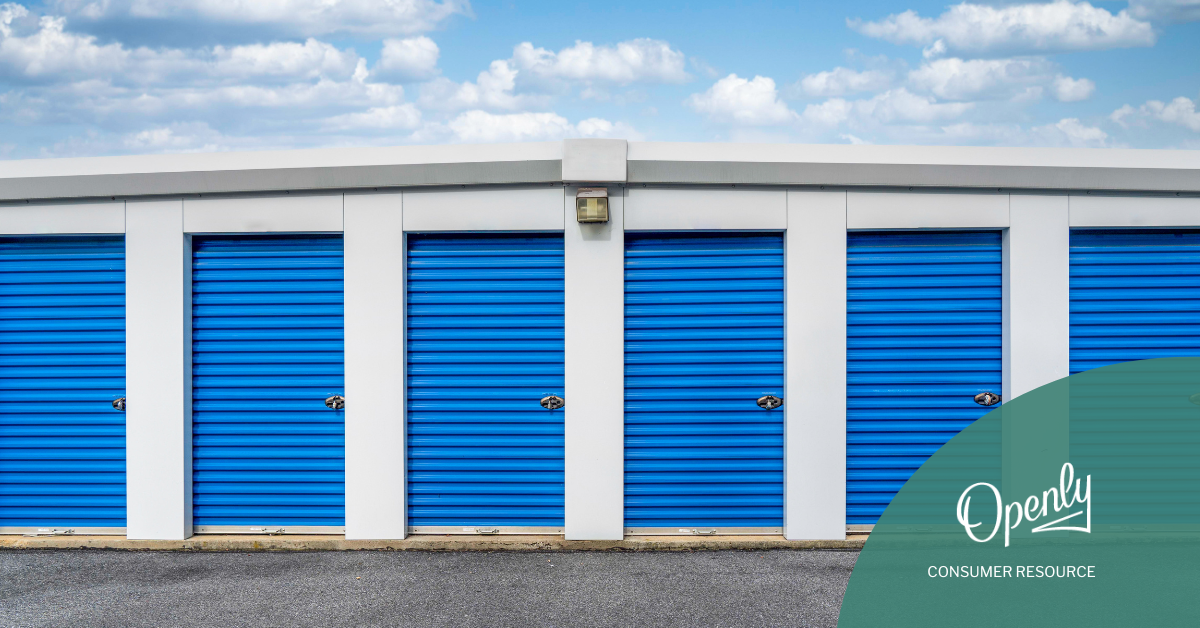Offsite storage units are a quick and convenient solution for homeowners who are running out of space or seeking a secure spot for their belongings. But now you may be thinking, “Does homeowners insurance cover storage units?”
Understanding how your insurance works outside the home can help protect your stored belongings from theft, damage, or unexpected disasters. This knowledge can be a huge help in making sure that you avoid costly surprises. Let's unpack this important topic to help a homeowner like you feel confident about safeguarding your valuables.
At a glance:
- Homeowners insurance often covers belongings in storage units, but coverage is typically limited to a percentage of your total personal property coverage.
- Supplemental insurance options, like endorsements, can provide additional protection for valuable items or specific risks in storage units.
- Choosing a secure, climate-controlled storage facility and properly packing your belongings can minimize the risk of damage or loss.
Understanding homeowners insurance coverage
Protecting your belongings is a top priority, and homeowners insurance plays a critical role in that. Let's break down what homeowners insurance is and how it can help safeguard your possessions, both inside your home and in storage.
What is homeowners insurance?
Homeowners insurance provides financial protection for your home and personal property in case of any unexpected events like fires, theft, or natural disasters. Standard homeowners insurance policies typically include several main components, including:
- Dwelling coverage—Protects the structure of your home.
- Personal property coverage—Covers belongings inside and outside the house.
- Liability coverage—Protects against claims or lawsuits from third-party injuries on your property.
- Other structures coverage—Protects structures on your property not attached to your main dwelling, such as a detached garage or shed.
This extensive protection covers your home and its contents, and even certain situations outside your property under the policy. It’s a major safety net for many homeowners.
If you own multiple properties, consider getting or reviewing your second-home insurance to make sure you have appropriate coverage for your vacation or secondary residence.
Coverage for personal property
Personal property coverage extends beyond your home’s walls. This means your belongings are often covered even when they’re offsite, such as in a storage unit. However, most policies place limits on exactly how much coverage applies to offsite items—typically 10% of your total personal property coverage.
For example, if your homeowners insurance includes $100,000 in personal property coverage, only $10,000 might be available to cover stored items in a storage unit. Understanding these coverage limits can prepare you in terms of what you can expect in case of a claim. Additionally, scanning and reviewing your policy details can help you identify any specific conditions or scenarios where this off-premises coverage might be restricted.
Clarifying limits and exclusions
While homeowners insurance offers broad coverage, there are some important limitations and exclusions when it comes to storage units. Common restrictions include:
- High-value items—Jewelry, electronics, and collectibles typically require scheduled personal property coverage to be fully protected.
- Excluded items—Items like vehicles or business inventory stored in a unit may not be covered under a standard policy.
- Policy-specific conditions—Some insurance policies exclude damage caused by pests, mold, or certain natural disasters.
Types of storage units
Self-storage facilities often vary in security and environmental conditions. For instance, climate-controlled units are ideal for sensitive items like antiquities or documents, as they protect against humidity and temperature fluctuations.
A climate-controlled facility near your home not only ensures greater peace of mind but may also quicken the process if a claim is necessary. The closer and more secure the facility, the better your chances of minimizing potential risks.
Factors that affect coverage for storage units
Policy limits
Insurance policies typically cap the coverage available for offsite belongings. Knowing your policy’s coverage limits can help you avoid unpleasant surprises. For instance, you might discover that a valuable heirloom stored in a unit exceeds these limits, leaving you underinsured without additional coverage.
This is why being well-prepared can make a difference. If your stored items— like family antiques or custom artwork—are particularly valuable, it’s important to address those gaps through policy updates or some supplementary insurance.
Supplemental insurance options
If you rely heavily on storage units for valuable items, consider some additional insurance options. Endorsements or add-ons like an “off-premises coverage” extension or “offsite storage endorsement” can fill in the gaps left by standard policies. Here's what these additions offer:
- Off-premises coverage extension—This endorsement expands the scope of your existing homeowners insurance policy to provide better protection for items stored away from your home, such as in a storage unit, a friend's house, or even in your car.
- Offsite storage endorsement—This endorsement specifically targets coverage for items stored in self-storage units. It provides additional protection for high-value items and risks that are typically excluded in standard policies, such as damage from specific natural disasters (e.g., floods or earthquakes) at a storage facility.
Supplemental insurance is particularly important for high-value or irreplaceable items. Taking the time to assess your policy and explore enhancements like the ones mentioned can guarantee that nothing slips through the cracks.
Common exclusions in storage unit coverage
While homeowners insurance offers some coverage for stored items, it's important to be aware of common exclusions. Understanding what your insurance policy does not cover can help you avoid unexpected financial burdens if something happens to your belongings in storage.
Theft and vandalism
Theft or vandalism is usually covered, but not without limits. Expensive items like luxury watches or high-end electronics may require additional coverage to guarantee full protection.
If your self-storage facility boasts robust security measures, it may provide an added layer of reassurance.
Water damage
Standard policies often exclude water damage from floods or leaks, particularly in non-climate-controlled storage units. If water damage is a concern, consider facilities with proper drainage systems or look for an endorsement or policy for flood insurance.
Natural disasters
Events like earthquakes are commonly excluded unless explicitly added to your policy. Check whether your insurance provider offers optional coverage for these risks.
Natural disasters pose unpredictable threats, making it important for you to stay ahead with personalized policy solutions, especially if you live in areas prone to these events.
Damages from mice or pests
Unfortunately, most policies exclude damages caused by rodents or insects. Proper packing, such as using airtight containers, and choosing a reputable storage unit company can mitigate this risk.
Rodent damage is one of the most common storage unit pitfalls, so addressing this early through precautionary measures can save significant headaches later.
How to protect your belongings in storage units
Protecting your stored belongings goes beyond just having insurance. There are several proactive steps you can take to minimize risks and ensure your items stay safe, from choosing the right storage facility to carefully packing your possessions.
Use insurance add-ons
For extra peace of mind, explore add-ons like scheduled personal property coverage or additional storage insurance. These options provide tailored protection for valuable or fragile items.
Choosing the right storage facility
The storage facility you choose plays a critical role in safeguarding your belongings. Look for:
- Security measures—Features like video surveillance, gated access, and on-site staff enhance safety.
- Climate control—Ideal for avoiding damage to sensitive items from temperature fluctuations or moisture.
Organizing and packing belongings properly
Packing your items with care reduces the risk of damage. Make sure to use sturdy boxes, avoid plastic bags (which trap moisture), and elevate belongings off the ground to prevent water damage. You may also consider creating an inventory list to track what’s stored, making insurance claims easier if needed.
Proper organization can also prevent accidental losses and simplify claim processes. A well-maintained inventory provides clarity and ease in any unfortunate events.
Steps to take if something happens to your stored property
Even with the best preparation, accidents can happen. Knowing what steps to take if your stored property is damaged or stolen can make the claims process smoother and help you recover your losses.
1. File a claim with your insurance
If damage or theft happens, contact your insurance provider promptly. Document the loss by taking photos and providing receipts or an inventory list as proof of ownership.
Filing a claim can be daunting, but keeping thorough records simplifies the experience and helps resolve matters efficiently.
2. Work with the storage facility
Some self-storage facilities offer their own insurance policies or require liability waivers. Understanding these terms can simplify the claims process.
3. Avoiding common mistakes
Common oversights include failing to review your insurance policy details, neglecting to update insurance for stored items, or relying solely on the storage company’s coverage. Staying informed means you’re better prepared for any eventuality.
Choose Openly for comprehensive storage coverage
Homeowners insurance often covers belongings stored in storage units, but understanding the limits and exclusions is key to better protect against financial loss. Take proactive steps like adding supplemental coverage, selecting a secure self-storage facility, and organizing your items to minimize risks. With Openly’s innovative and transparent policies, you can confidently protect your stored belongings and enjoy peace of mind.
Ready to ensure comprehensive protection for your home and storage needs?
- Get a home insurance quote online today to explore tailored homeowner insurance solutions.
- Prefer personalized assistance? Find a local home insurance agent near you to discuss your coverage options and get expert advice.
Openly is here to help you review your insurance coverage and secure the right policy for your needs.
*We provide this information to help you understand insurance. Any coverage is subject to the terms of your policy. Please refer to your policy and declarations page for complete terms, conditions and coverage details.




